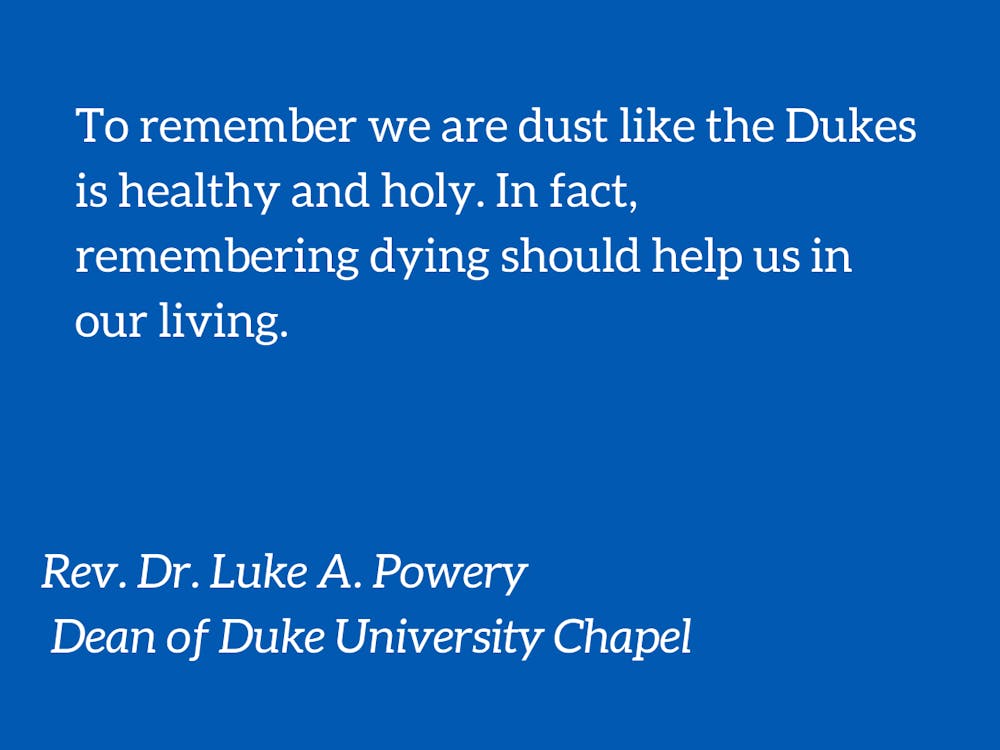This first month of the new academic year has been very sobering. As if a health pandemic wasn’t enough to wake us up to our reality as mortals, there have been several unexpected deaths—Duke staff members, alumni and others at the university and health system. Tragedies seem to persist, and death seems to be pervasive.
On top of this, we recently had the September 11 twentieth anniversary commemorations, including an interfaith vigil on the front steps of Duke Chapel. It was a fitting location. I say this because standing on those steps is like standing on the edge of death. Let me explain.
First, Duke Chapel is in the shape of a cross. It is cruciform. The cross was an ancient tool of torture and death. Of course, Christians view the cross redemptively as well, but the cross was like an ancient electric chair on death row. It wasn’t a shiny object like some of the crosses people wear around their necks these days. It was bloody and gruesome. It was a symbol of death, and this is the shape of Duke Chapel.
Second, you may know that there is a crypt inside the chapel at the lower level. If you walk down the middle aisle in the main sanctuary and then hang a left, on your right you’ll see a door that will lead you down a set of stairs into the crypt. The crypt is where several former Duke presidents, a former dean of the chapel and others are buried. The crypt, the resting place of these men and women, is a part of the structure of Duke Chapel.
Third, there is Memorial Chapel, the small chapel on the same side as the crypt but on the main level. There, three Dukes are laid to rest—Washington Duke, James B. Duke and Benjamin N. Duke. Death is built into the very architecture of Duke Chapel.
The spiritual center of this major research university is constructed with death in view. I don’t know exactly what James B. Duke had in mind when he was walking around with the then-Duke President William Preston Few to find a suitable location for Duke Chapel. But he wanted the Chapel at the highest point of the land and at the center of campus. He said, “I want the central building to be a great towering church which will dominate all of the surrounding buildings, because such an edifice would be bound to have a profound influence on the spiritual life of the young men and women who come here.”
For years, Duke Chapel has had a profound influence on many thousands of people, and one of those influences today should be to help us to pause and to reflect on death and dying. It calls us to remember that we are mortal human beings. The word "human" comes from "humus" which means "from the earth" or "from the ground." Our common ground as human beings is that we are all “from the ground.” Humans are dust, holy dust of God, and to dust we will one day return. Embracing our dustiness, our mortality, our dying, is an important part of the spiritual life.
In the Hebrew scriptures, we hear that the prophet Ezekiel says, “The hand of the Lord came upon me, and he brought me out by the spirit of the Lord and set me down in the middle of a valley; it was full of bones.” This scene is known as “Ezekiel and the valley of dry bones” and what is so intriguing when considering the spiritual life is that the Spirit is the one who brings Ezekiel to this valley of bones, which is the place of contamination and death. The Spirit leads him to see death as part of his spiritual journey and reveals that there should be no avoidance of the reality of death—even in a life with God.
This is what Duke Chapel’s architecture does. Its visual influence on campus cannot be avoided, nor should it be, because it tells us that the spiritual life includes remembering death, even our own death. We shouldn’t need a pandemic or have to wear masks to be mindful of our mortality, because Duke Chapel has stood at the highest place on campus for nearly ninety years as a spiritual blessing to remind us of death and dying.
To remember we are dust like the Dukes is healthy and holy. In fact, remembering dying should help us in our living. Remembering that we are all dust could help us live with what I call an “ethics of dust.” That is, recognizing each other as dust can shape our interactions with each other and hopefully help us become more fully human, humane, loving, and just.
In one of his essays, Yale professor and theologian Willie Jennings, who taught at Duke Divinity School for many years, writes this: “We are joined at the site of the dirt, and the dirt is our undeniable kin. Even geographic distance and the difference of strange tongues cannot thwart this truth—we are creatures bound together.”
Perhaps, the architecture of death at the chapel doesn’t only call us to see death, including our own, but also encourages us to live with each other in deeper community because we are bound to each other in the family of holy dust.
The Rev. Dr. Luke A. Powery is the Dean of Duke University Chapel. His column runs on alternate Mondays.
Get The Chronicle straight to your inbox
Signup for our weekly newsletter. Cancel at any time.

